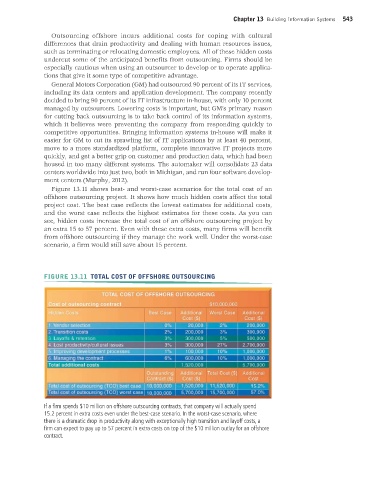Page 544 -
P. 544
Chapter 13 Building Information Systems 543
Outsourcing offshore incurs additional costs for coping with cultural
differences that drain productivity and dealing with human resources issues,
such as terminating or relocating domestic employees. All of these hidden costs
undercut some of the anticipated benefits from outsourcing. Firms should be
especially cautious when using an outsourcer to develop or to operate applica-
tions that give it some type of competitive advantage.
General Motors Corporation (GM) had outsourced 90 percent of its IT services,
including its data centers and application development. The company recently
decided to bring 90 percent of its IT infrastructure in-house, with only 10 percent
managed by outsourcers. Lowering costs is important, but GM’s primary reason
for cutting back outsourcing is to take back control of its information systems,
which it believes were preventing the company from responding quickly to
competitive opportunities. Bringing information systems in-house will make it
easier for GM to cut its sprawling list of IT applications by at least 40 percent,
move to a more standardized platform, complete innovative IT projects more
quickly, and get a better grip on customer and production data, which had been
housed in too many different systems. The automaker will consolidate 23 data
centers worldwide into just two, both in Michigan, and run four software develop-
ment centers (Murphy, 2012).
Figure 13.11 shows best- and worst-case scenarios for the total cost of an
offshore outsourcing project. It shows how much hidden costs affect the total
project cost. The best case reflects the lowest estimates for additional costs,
and the worst case reflects the highest estimates for these costs. As you can
see, hidden costs increase the total cost of an offshore outsourcing project by
an extra 15 to 57 percent. Even with these extra costs, many firms will benefit
from offshore outsourcing if they manage the work well. Under the worst-case
scenario, a firm would still save about 15 percent.
FIGURE 13.11 TOTAL COST OF OFFSHORE OUTSOURCING
If a firm spends $10 million on offshore outsourcing contracts, that company will actually spend
15.2 percent in extra costs even under the best-case scenario. In the worst-case scenario, where
there is a dramatic drop in productivity along with exceptionally high transition and layoff costs, a
firm can expect to pay up to 57 percent in extra costs on top of the $10 million outlay for an offshore
contract.
MIS_13_Ch_13 global.indd 543 1/17/2013 2:31:25 PM

